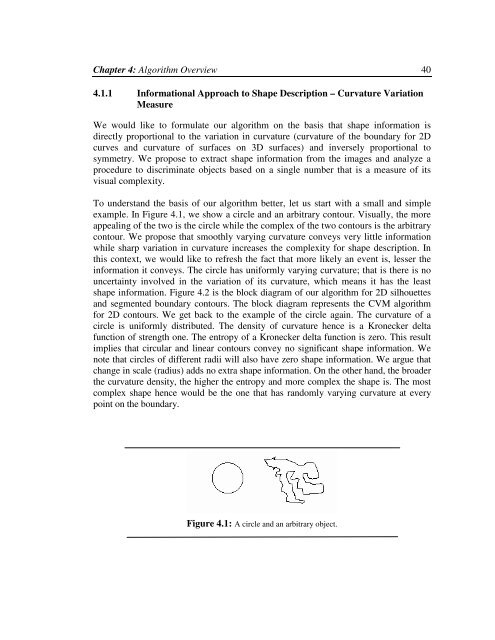To the Graduate Council: I am submitting herewith a thesis written by ...
To the Graduate Council: I am submitting herewith a thesis written by ...
To the Graduate Council: I am submitting herewith a thesis written by ...
Create successful ePaper yourself
Turn your PDF publications into a flip-book with our unique Google optimized e-Paper software.
Chapter 4: Algorithm Overview 404.1.1 Informational Approach to Shape Description – Curvature VariationMeasureWe would like to formulate our algorithm on <strong>the</strong> basis that shape information isdirectly proportional to <strong>the</strong> variation in curvature (curvature of <strong>the</strong> boundary for 2Dcurves and curvature of surfaces on 3D surfaces) and inversely proportional tosymmetry. We propose to extract shape information from <strong>the</strong> images and analyze aprocedure to discriminate objects based on a single number that is a measure of itsvisual complexity.<strong>To</strong> understand <strong>the</strong> basis of our algorithm better, let us start with a small and simpleex<strong>am</strong>ple. In Figure 4.1, we show a circle and an arbitrary contour. Visually, <strong>the</strong> moreappealing of <strong>the</strong> two is <strong>the</strong> circle while <strong>the</strong> complex of <strong>the</strong> two contours is <strong>the</strong> arbitrarycontour. We propose that smoothly varying curvature conveys very little informationwhile sharp variation in curvature increases <strong>the</strong> complexity for shape description. Inthis context, we would like to refresh <strong>the</strong> fact that more likely an event is, lesser <strong>the</strong>information it conveys. The circle has uniformly varying curvature; that is <strong>the</strong>re is nouncertainty involved in <strong>the</strong> variation of its curvature, which means it has <strong>the</strong> leastshape information. Figure 4.2 is <strong>the</strong> block diagr<strong>am</strong> of our algorithm for 2D silhouettesand segmented boundary contours. The block diagr<strong>am</strong> represents <strong>the</strong> CVM algorithmfor 2D contours. We get back to <strong>the</strong> ex<strong>am</strong>ple of <strong>the</strong> circle again. The curvature of acircle is uniformly distributed. The density of curvature hence is a Kronecker deltafunction of strength one. The entropy of a Kronecker delta function is zero. This resultimplies that circular and linear contours convey no significant shape information. Wenote that circles of different radii will also have zero shape information. We argue thatchange in scale (radius) adds no extra shape information. On <strong>the</strong> o<strong>the</strong>r hand, <strong>the</strong> broader<strong>the</strong> curvature density, <strong>the</strong> higher <strong>the</strong> entropy and more complex <strong>the</strong> shape is. The mostcomplex shape hence would be <strong>the</strong> one that has randomly varying curvature at everypoint on <strong>the</strong> boundary.Figure 4.1: A circle and an arbitrary object.
















